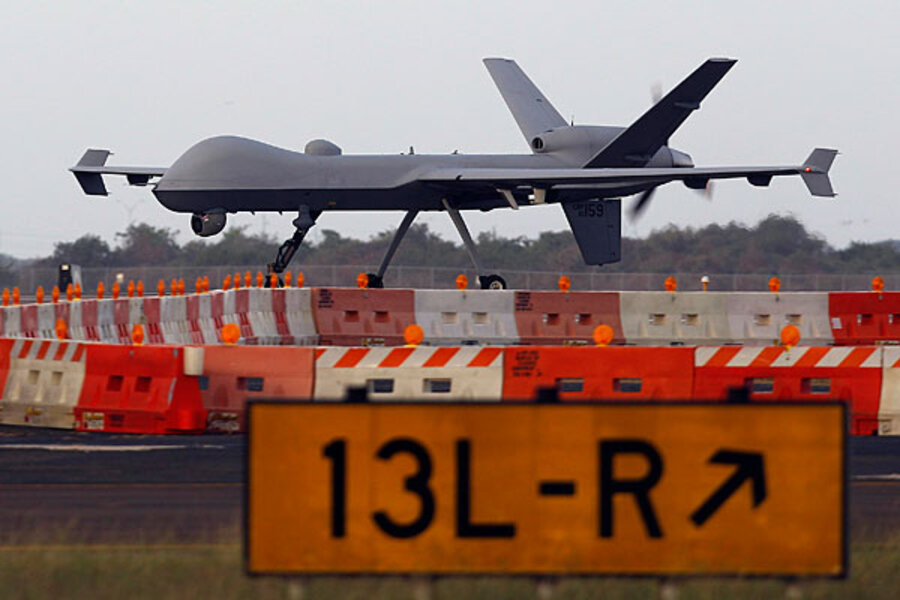What secrets can Iran learn from intercepted US drone?
Loading...
As Iranian officials bragged Sunday that they had taken down a US spy drone equipped with top secret stealth technology, defense analysts in Washington began scrambling to assess just how harmful such a scenario would be for US national security.
In the first phase of damage control, Pentagon officials were quick to deny Iran’s claim. “We have no indication that [the drone] was brought down by hostile fire,” one senior US official assured reporters.
But despite the semantics – perhaps it crashed rather than being shot down, for example – it seems quite possible that the unmanned aerial vehicle (UAV) may indeed be in Iranian hands, analysts say.
This would mark the first known case of a drone – ubiquitous in the US wars in Iraq and Afghanistan – falling into hostile hands.
“The UAV to which the Iranians are referring may be a US unarmed reconnaissance aircraft that had been flying a mission over western Afghanistan late last week,” NATO officials in Afghanistan said in a statement Sunday.
This particular UAV is more sophisticated than the Predator or Reaper drones that regularly patrol the skies over Iraq and Afghanistan, streaming video and executing strikes on insurgent hideouts.
Nicknamed the “Beast of Kandahar,” the unarmed RQ-170 is manufactured by Lockheed Martin and was reportedly used in the surveillance of Osama bin Laden in Pakistan before the US SEAL Team 6 raid on his compound.
What does Iran stand to learn from the intercepted drone?
The US military keeps a close hold on the technological feats and intelligence-gathering capacities of these drones, but what is clear is that “any stealth technology is remarkably sophisticated in design,” notes Anthony Cordesman, a national security analyst at the Center for Strategic and International Studies in Washington, D.C.
The question, he adds, is how readily the drone might be reverse engineered. That answer “depends on something we just don’t know: how good the Iranians are at this, and how likely they are to bring in the Chinese, the North Koreans, or others” to deconstruct the UAV and mine it for secrets, Dr. Cordesman says.
“Can they activate enough of the sensor data in ways you can actually read to know the limits of the vehicle?” Cordesman asks. “If you have it, how much can you exploit it? Are they going to bring in a third party? Iran is not unsophisticated, but it’s not at the level of technology as China.”
Just studying the futuristic wedge shape of the RQ-170 – which is designed to more easily penetrate air defenses in a way that the Predators and Reapers can not – could prove helpful for those trying to exploit US military technology.
“The shape of any drone device represents an incredible amount of design and engineering,” Cordesman says.
So, too, does the coating on the exterior of the aircraft, which increases its stealth capabilities.
All this said, it’s not clear how much of the drone – whether it was shot down or crashed – landed intact and in salvageable condition.
It’s telling, analysts point out that Iran has not released photos of the particular UAV that is suspected lost, but rather stock photos drawn from web sources.
Because Iran has made no secret of its desire to develop unmanned aerial vehicles of its own, some US analysts speculate that the crash could have been a sophisticated ruse – just the sort of thing, they say, US intelligence officials might orchestrate to waste Iran’s time.
But US military mistakes happen often enough, and NATO officials acknowledged Sunday that they have been looking for a missing UAV – which was based in Afghanistan – for the better part of a week.
Yet analysts point out that even in a worst-case scenario, it is likely that the UAV comes equipped with one or a number of “self-destruct” mechanisms in place to wipe out data links and even destroy the craft.
Designers of the RQ-170 would likely plan for the possibility of such a craft being captured by enemy forces, analysts say.
That said, if such a drone were to crash hard enough – or be shot down effectively – “you don’t need a classic ‘self-destruct button,’ ” notes Cordesman. “Anything that flies into the ground at several hundred miles an hour tends to self-destruct.”





